Financial Statement Analysis of Vodafone Group
VerifiedAdded on 2023/01/19
|14
|2946
|44
AI Summary
This report assesses the financial performance of Vodafone through ratio analysis and compares it with Deutsche Telekom. It analyzes profitability, liquidity, efficiency, and solvency ratios to determine the company's financial health and competitive position.
Contribute Materials
Your contribution can guide someone’s learning journey. Share your
documents today.
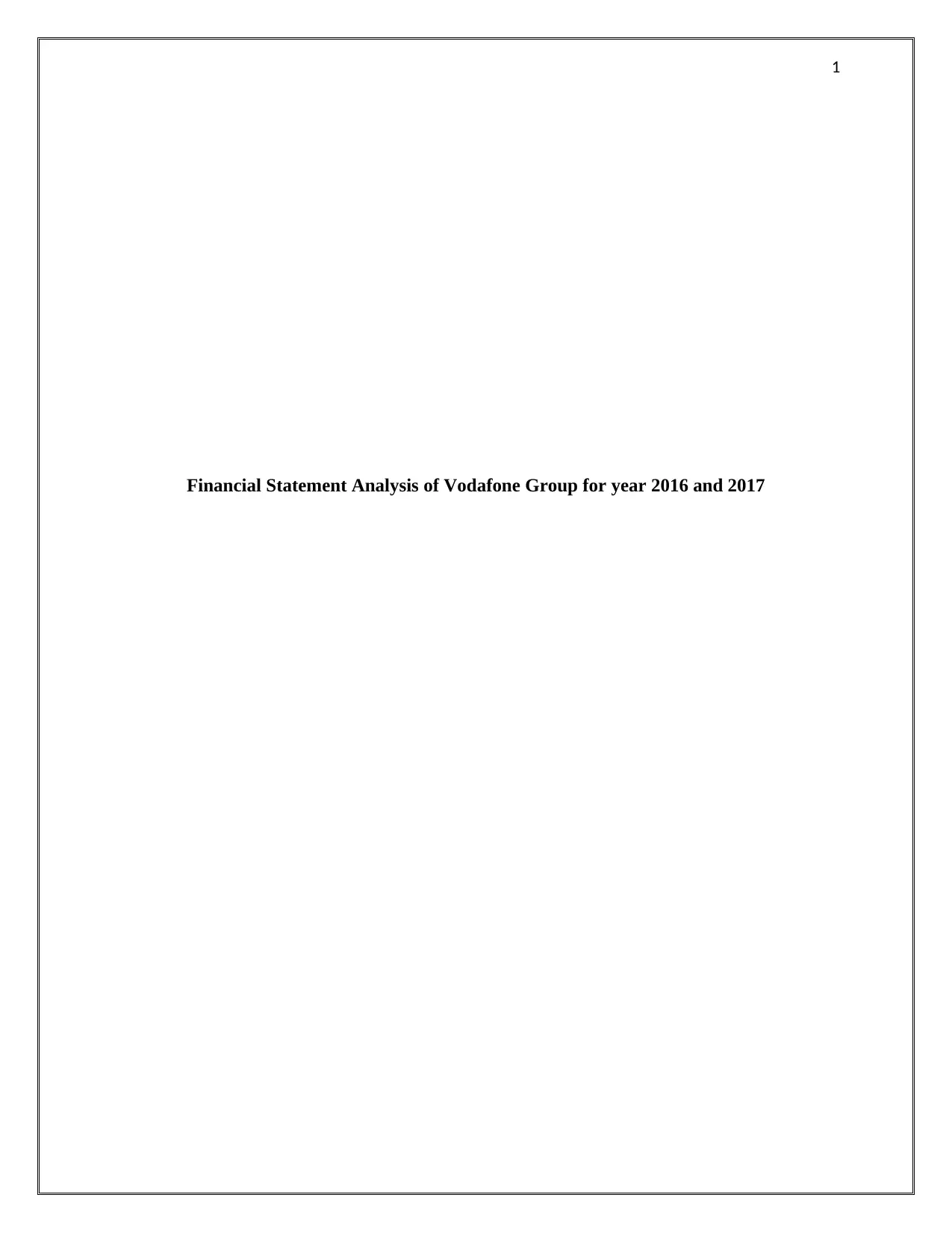
1
Financial Statement Analysis of Vodafone Group for year 2016 and 2017
Financial Statement Analysis of Vodafone Group for year 2016 and 2017
Secure Best Marks with AI Grader
Need help grading? Try our AI Grader for instant feedback on your assignments.
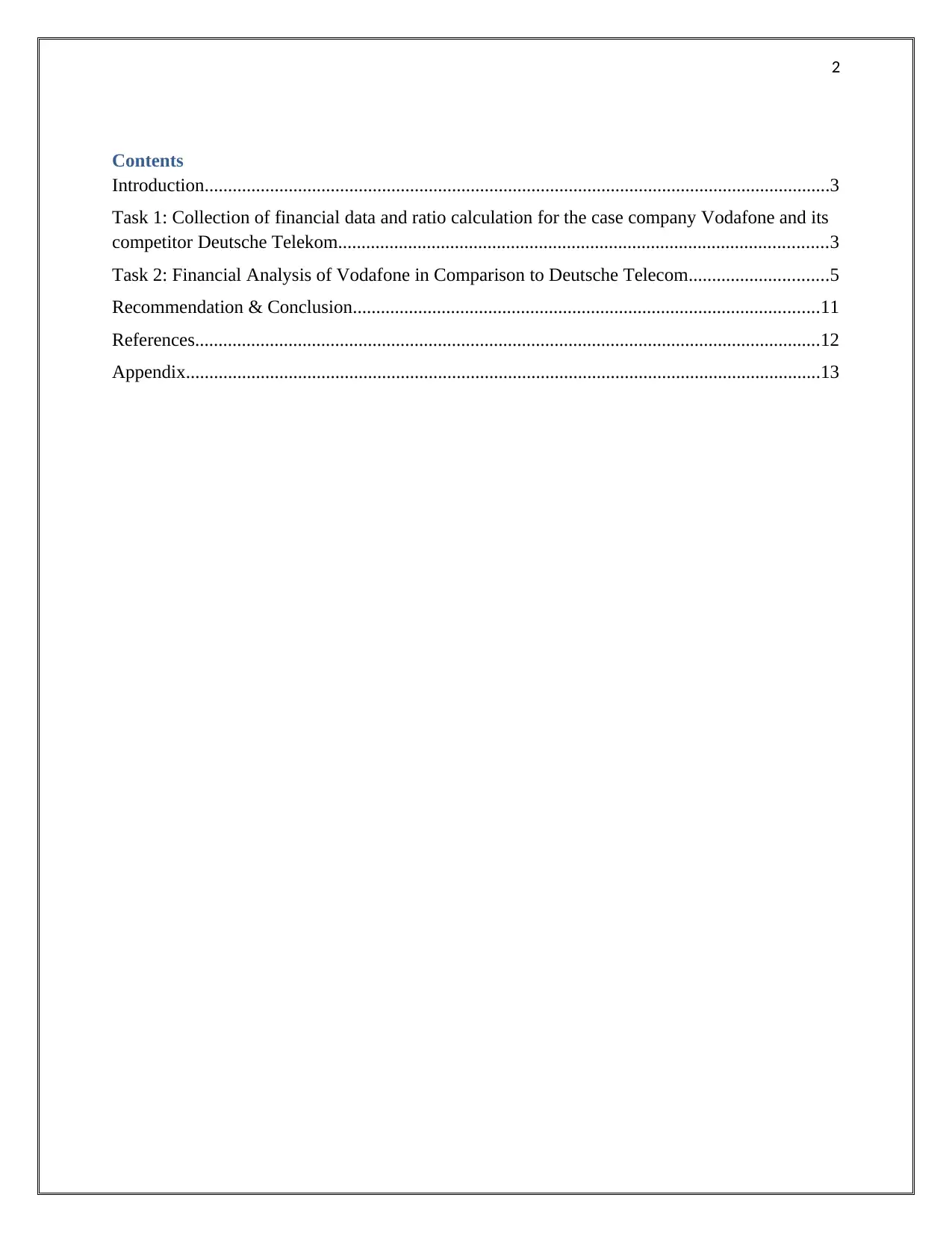
2
Contents
Introduction......................................................................................................................................3
Task 1: Collection of financial data and ratio calculation for the case company Vodafone and its
competitor Deutsche Telekom.........................................................................................................3
Task 2: Financial Analysis of Vodafone in Comparison to Deutsche Telecom..............................5
Recommendation & Conclusion....................................................................................................11
References......................................................................................................................................12
Appendix........................................................................................................................................13
Contents
Introduction......................................................................................................................................3
Task 1: Collection of financial data and ratio calculation for the case company Vodafone and its
competitor Deutsche Telekom.........................................................................................................3
Task 2: Financial Analysis of Vodafone in Comparison to Deutsche Telecom..............................5
Recommendation & Conclusion....................................................................................................11
References......................................................................................................................................12
Appendix........................................................................................................................................13

3
Introduction
The financial ratio analysis is an adequate technique used in evaluation of the financial
performance of a company and thus determining its financial health in key terms of risk,
profitability, solvency, efficiency and many other aspects. In this context, this report intends to
assess the financial performance of a selected company, that is, Vodafone, a multinational
telecommunication company, through the technique of ratio analysis. The key ratios are
calculated with interpretation of the financial information provided within the financial
statements of the company for the year 2016-2017. The results achieved are interpreted and
compared with its competitor of Deutsche Telekom for examining the competitive position of
Vodafone and implications for future growth. The possible causes for the difference in
performance between Vodafone and its competitor is analyzed for assessing whether Vodafone
should be concerned about its competitor performance.
Task 1: Collection of financial data and ratio calculation for the case company Vodafone
and its competitor Deutsche Telekom
Profitability
Ratios
Vodafone Company Deutsche Company
Formula Year 2016 Year 2017 Year 2016 Year 2017
Return on
sales
Net profit/Net
Sales -10.28% -12.76% 4.25% 7.41%
Return on
Equity
Net
profit/Averag
e
Shareholder's
Equity
-5.73% -7.65% 8.06% 13.65%
Gross profit
Margin
Gross
Profit/Net
Sales
26.29% 27.41% 49.27% 49.08%
Return on
capital
employed
EBIT/(Total
Assets-
Current
Liabilities)
1.04% 3.00% 7.94% 8.23%
(Deutsche: Annual Report, 2016 and 2017) and (Vodafone: Annual Report, 2016 and 2017)
Liquidity Ratios
Vodafone Company Deutsche Company
Formula Year
2016
Year
2017
Year
2016
Year
2017
Introduction
The financial ratio analysis is an adequate technique used in evaluation of the financial
performance of a company and thus determining its financial health in key terms of risk,
profitability, solvency, efficiency and many other aspects. In this context, this report intends to
assess the financial performance of a selected company, that is, Vodafone, a multinational
telecommunication company, through the technique of ratio analysis. The key ratios are
calculated with interpretation of the financial information provided within the financial
statements of the company for the year 2016-2017. The results achieved are interpreted and
compared with its competitor of Deutsche Telekom for examining the competitive position of
Vodafone and implications for future growth. The possible causes for the difference in
performance between Vodafone and its competitor is analyzed for assessing whether Vodafone
should be concerned about its competitor performance.
Task 1: Collection of financial data and ratio calculation for the case company Vodafone
and its competitor Deutsche Telekom
Profitability
Ratios
Vodafone Company Deutsche Company
Formula Year 2016 Year 2017 Year 2016 Year 2017
Return on
sales
Net profit/Net
Sales -10.28% -12.76% 4.25% 7.41%
Return on
Equity
Net
profit/Averag
e
Shareholder's
Equity
-5.73% -7.65% 8.06% 13.65%
Gross profit
Margin
Gross
Profit/Net
Sales
26.29% 27.41% 49.27% 49.08%
Return on
capital
employed
EBIT/(Total
Assets-
Current
Liabilities)
1.04% 3.00% 7.94% 8.23%
(Deutsche: Annual Report, 2016 and 2017) and (Vodafone: Annual Report, 2016 and 2017)
Liquidity Ratios
Vodafone Company Deutsche Company
Formula Year
2016
Year
2017
Year
2016
Year
2017

4
Quick Ratio
(Current Assets-
Inventory-Prepaid
Expenses)/Current
Liabilities
0.75 0.82 0.75 0.67
Current Ratio
Current
Assets/Current
Liabilities
0.76 0.83 0.80 0.75
(Deutsche: Annual Report, 2016 and 2017) and (Vodafone: Annual Report, 2016 and 2017)
Efficiency
Ratios
Vodafone Company Deutsche Company
Formula Year
2016
Year
2017
Year
2016
Year
2017
Current trade
payables days
(365/Average
Account
Payables)/Total
Purchases 62.85 72.25 106.59 101.45
Asset
Utilization
Ratio
Net
Sales/Average
Total Assets 0.29 0.29 0.50 0.52
Current trade
receivables
days
(365/Average
Account
Receivables)/Net
Credit Sales 34.84 40.38 46.44 46.47
Stock Days
(365*Average
inventory)/COG
S 6.98 6.82 17.11 17.28
(Deutsche: Annual Report, 2016 and 2017) and (Vodafone: Annual Report, 2016 and 2017)
Solvency
Ratios
Vodafone Company Deutsche Company
Formula Year
2016
Year
2017
Year
2016
Year
2017
Interest
Coverage Ratio
EBIT/Interest
Expenses 0.65 2.65 3.38 3.73
Gearing Ratio
Total
Liabilities/Shareholder
s Equity 98.63% 109.83% 282.25% 232.79%
(Deutsche: Annual Report, 2016 and 2017) and (Vodafone: Annual Report, 2016 and 2017)
Quick Ratio
(Current Assets-
Inventory-Prepaid
Expenses)/Current
Liabilities
0.75 0.82 0.75 0.67
Current Ratio
Current
Assets/Current
Liabilities
0.76 0.83 0.80 0.75
(Deutsche: Annual Report, 2016 and 2017) and (Vodafone: Annual Report, 2016 and 2017)
Efficiency
Ratios
Vodafone Company Deutsche Company
Formula Year
2016
Year
2017
Year
2016
Year
2017
Current trade
payables days
(365/Average
Account
Payables)/Total
Purchases 62.85 72.25 106.59 101.45
Asset
Utilization
Ratio
Net
Sales/Average
Total Assets 0.29 0.29 0.50 0.52
Current trade
receivables
days
(365/Average
Account
Receivables)/Net
Credit Sales 34.84 40.38 46.44 46.47
Stock Days
(365*Average
inventory)/COG
S 6.98 6.82 17.11 17.28
(Deutsche: Annual Report, 2016 and 2017) and (Vodafone: Annual Report, 2016 and 2017)
Solvency
Ratios
Vodafone Company Deutsche Company
Formula Year
2016
Year
2017
Year
2016
Year
2017
Interest
Coverage Ratio
EBIT/Interest
Expenses 0.65 2.65 3.38 3.73
Gearing Ratio
Total
Liabilities/Shareholder
s Equity 98.63% 109.83% 282.25% 232.79%
(Deutsche: Annual Report, 2016 and 2017) and (Vodafone: Annual Report, 2016 and 2017)
Secure Best Marks with AI Grader
Need help grading? Try our AI Grader for instant feedback on your assignments.
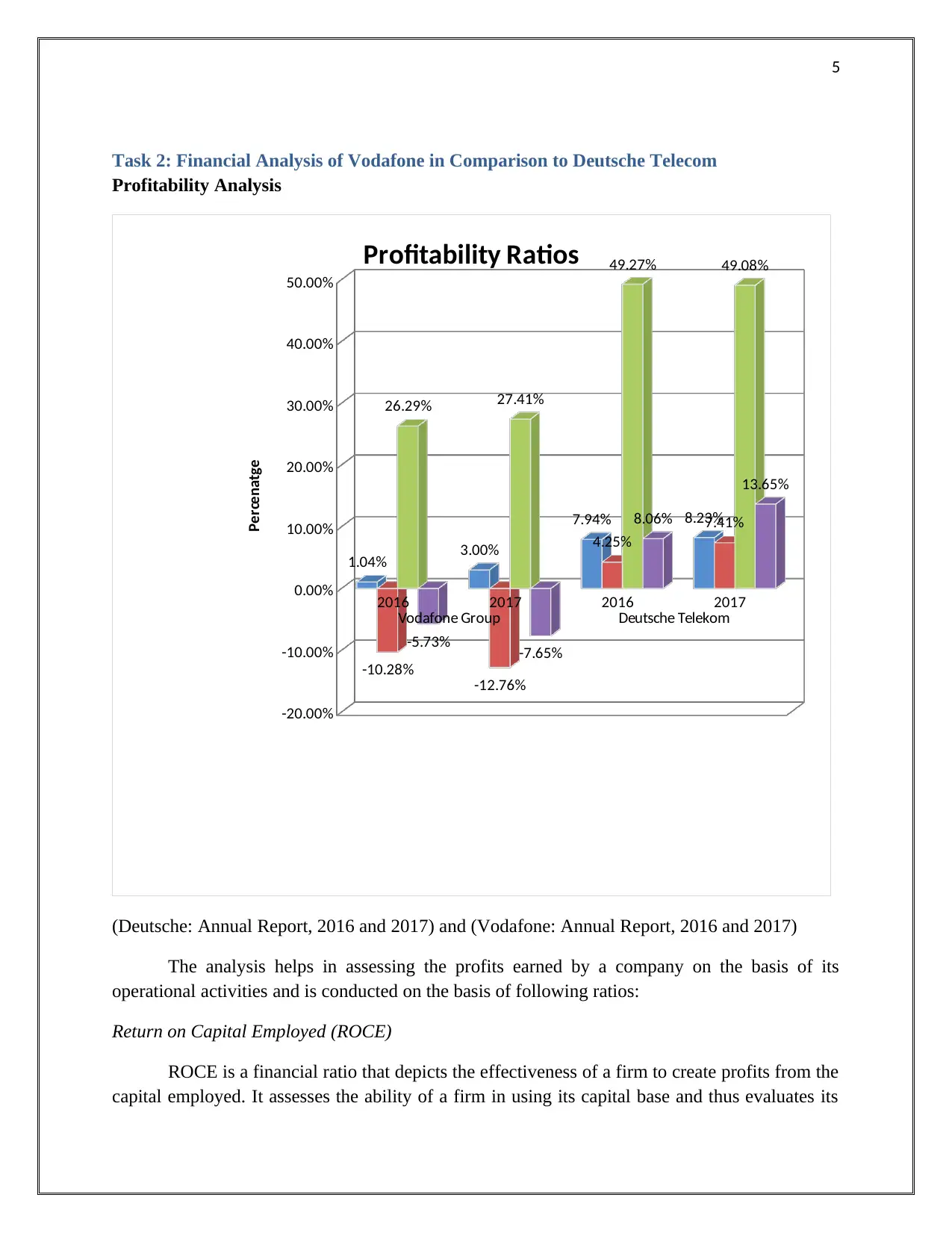
5
Task 2: Financial Analysis of Vodafone in Comparison to Deutsche Telecom
Profitability Analysis
2016 2017 2016 2017
Vodafone Group Deutsche Telekom
-20.00%
-10.00%
0.00%
10.00%
20.00%
30.00%
40.00%
50.00%
1.04% 3.00%
7.94% 8.23%
-10.28% -12.76%
4.25%
7.41%
26.29% 27.41%
49.27% 49.08%
-5.73% -7.65%
8.06%
13.65%
Profitability Ratios
Percenatge
(Deutsche: Annual Report, 2016 and 2017) and (Vodafone: Annual Report, 2016 and 2017)
The analysis helps in assessing the profits earned by a company on the basis of its
operational activities and is conducted on the basis of following ratios:
Return on Capital Employed (ROCE)
ROCE is a financial ratio that depicts the effectiveness of a firm to create profits from the
capital employed. It assesses the ability of a firm in using its capital base and thus evaluates its
Task 2: Financial Analysis of Vodafone in Comparison to Deutsche Telecom
Profitability Analysis
2016 2017 2016 2017
Vodafone Group Deutsche Telekom
-20.00%
-10.00%
0.00%
10.00%
20.00%
30.00%
40.00%
50.00%
1.04% 3.00%
7.94% 8.23%
-10.28% -12.76%
4.25%
7.41%
26.29% 27.41%
49.27% 49.08%
-5.73% -7.65%
8.06%
13.65%
Profitability Ratios
Percenatge
(Deutsche: Annual Report, 2016 and 2017) and (Vodafone: Annual Report, 2016 and 2017)
The analysis helps in assessing the profits earned by a company on the basis of its
operational activities and is conducted on the basis of following ratios:
Return on Capital Employed (ROCE)
ROCE is a financial ratio that depicts the effectiveness of a firm to create profits from the
capital employed. It assesses the ability of a firm in using its capital base and thus evaluates its
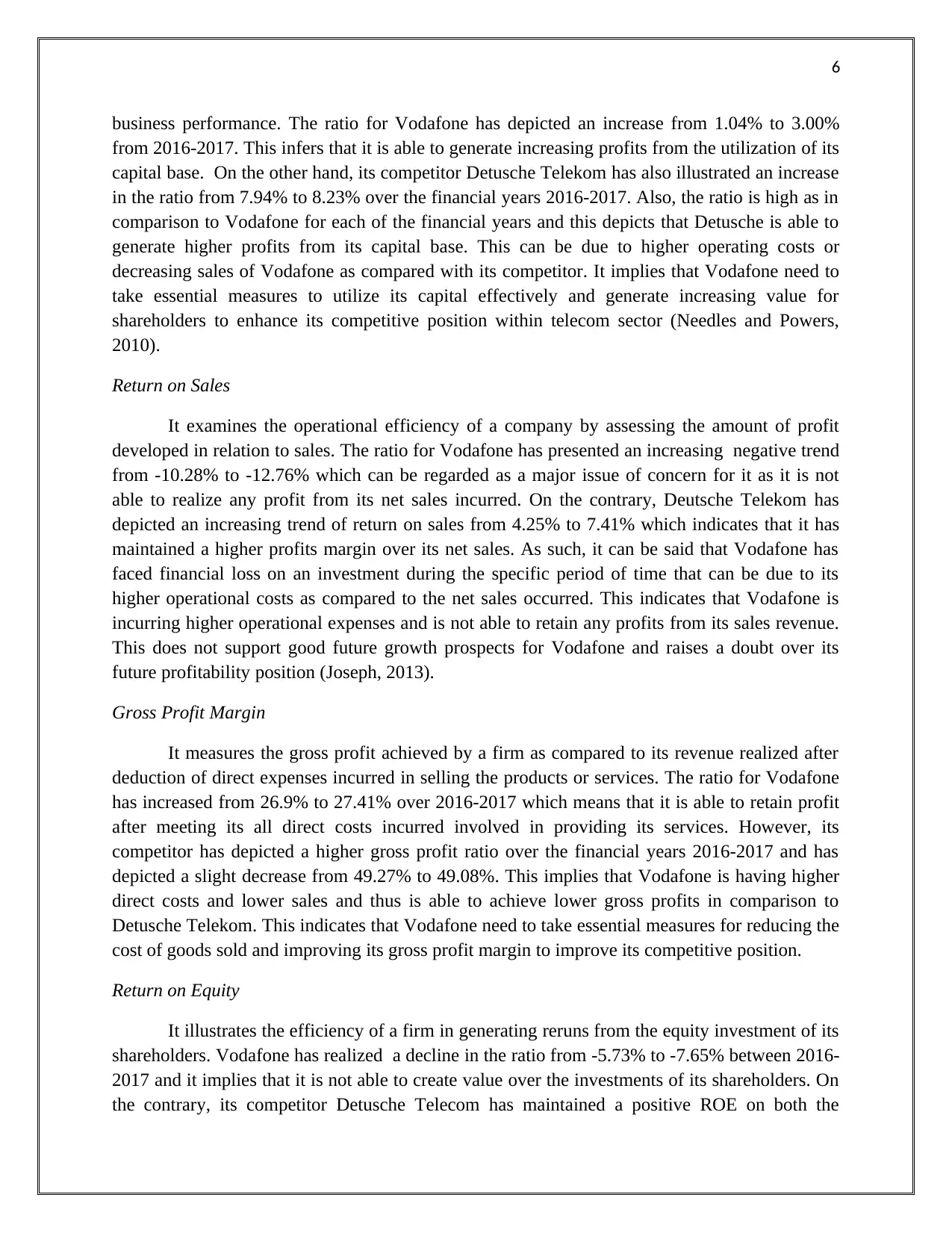
6
business performance. The ratio for Vodafone has depicted an increase from 1.04% to 3.00%
from 2016-2017. This infers that it is able to generate increasing profits from the utilization of its
capital base. On the other hand, its competitor Detusche Telekom has also illustrated an increase
in the ratio from 7.94% to 8.23% over the financial years 2016-2017. Also, the ratio is high as in
comparison to Vodafone for each of the financial years and this depicts that Detusche is able to
generate higher profits from its capital base. This can be due to higher operating costs or
decreasing sales of Vodafone as compared with its competitor. It implies that Vodafone need to
take essential measures to utilize its capital effectively and generate increasing value for
shareholders to enhance its competitive position within telecom sector (Needles and Powers,
2010).
Return on Sales
It examines the operational efficiency of a company by assessing the amount of profit
developed in relation to sales. The ratio for Vodafone has presented an increasing negative trend
from -10.28% to -12.76% which can be regarded as a major issue of concern for it as it is not
able to realize any profit from its net sales incurred. On the contrary, Deutsche Telekom has
depicted an increasing trend of return on sales from 4.25% to 7.41% which indicates that it has
maintained a higher profits margin over its net sales. As such, it can be said that Vodafone has
faced financial loss on an investment during the specific period of time that can be due to its
higher operational costs as compared to the net sales occurred. This indicates that Vodafone is
incurring higher operational expenses and is not able to retain any profits from its sales revenue.
This does not support good future growth prospects for Vodafone and raises a doubt over its
future profitability position (Joseph, 2013).
Gross Profit Margin
It measures the gross profit achieved by a firm as compared to its revenue realized after
deduction of direct expenses incurred in selling the products or services. The ratio for Vodafone
has increased from 26.9% to 27.41% over 2016-2017 which means that it is able to retain profit
after meeting its all direct costs incurred involved in providing its services. However, its
competitor has depicted a higher gross profit ratio over the financial years 2016-2017 and has
depicted a slight decrease from 49.27% to 49.08%. This implies that Vodafone is having higher
direct costs and lower sales and thus is able to achieve lower gross profits in comparison to
Detusche Telekom. This indicates that Vodafone need to take essential measures for reducing the
cost of goods sold and improving its gross profit margin to improve its competitive position.
Return on Equity
It illustrates the efficiency of a firm in generating reruns from the equity investment of its
shareholders. Vodafone has realized a decline in the ratio from -5.73% to -7.65% between 2016-
2017 and it implies that it is not able to create value over the investments of its shareholders. On
the contrary, its competitor Detusche Telecom has maintained a positive ROE on both the
business performance. The ratio for Vodafone has depicted an increase from 1.04% to 3.00%
from 2016-2017. This infers that it is able to generate increasing profits from the utilization of its
capital base. On the other hand, its competitor Detusche Telekom has also illustrated an increase
in the ratio from 7.94% to 8.23% over the financial years 2016-2017. Also, the ratio is high as in
comparison to Vodafone for each of the financial years and this depicts that Detusche is able to
generate higher profits from its capital base. This can be due to higher operating costs or
decreasing sales of Vodafone as compared with its competitor. It implies that Vodafone need to
take essential measures to utilize its capital effectively and generate increasing value for
shareholders to enhance its competitive position within telecom sector (Needles and Powers,
2010).
Return on Sales
It examines the operational efficiency of a company by assessing the amount of profit
developed in relation to sales. The ratio for Vodafone has presented an increasing negative trend
from -10.28% to -12.76% which can be regarded as a major issue of concern for it as it is not
able to realize any profit from its net sales incurred. On the contrary, Deutsche Telekom has
depicted an increasing trend of return on sales from 4.25% to 7.41% which indicates that it has
maintained a higher profits margin over its net sales. As such, it can be said that Vodafone has
faced financial loss on an investment during the specific period of time that can be due to its
higher operational costs as compared to the net sales occurred. This indicates that Vodafone is
incurring higher operational expenses and is not able to retain any profits from its sales revenue.
This does not support good future growth prospects for Vodafone and raises a doubt over its
future profitability position (Joseph, 2013).
Gross Profit Margin
It measures the gross profit achieved by a firm as compared to its revenue realized after
deduction of direct expenses incurred in selling the products or services. The ratio for Vodafone
has increased from 26.9% to 27.41% over 2016-2017 which means that it is able to retain profit
after meeting its all direct costs incurred involved in providing its services. However, its
competitor has depicted a higher gross profit ratio over the financial years 2016-2017 and has
depicted a slight decrease from 49.27% to 49.08%. This implies that Vodafone is having higher
direct costs and lower sales and thus is able to achieve lower gross profits in comparison to
Detusche Telekom. This indicates that Vodafone need to take essential measures for reducing the
cost of goods sold and improving its gross profit margin to improve its competitive position.
Return on Equity
It illustrates the efficiency of a firm in generating reruns from the equity investment of its
shareholders. Vodafone has realized a decline in the ratio from -5.73% to -7.65% between 2016-
2017 and it implies that it is not able to create value over the investments of its shareholders. On
the contrary, its competitor Detusche Telecom has maintained a positive ROE on both the
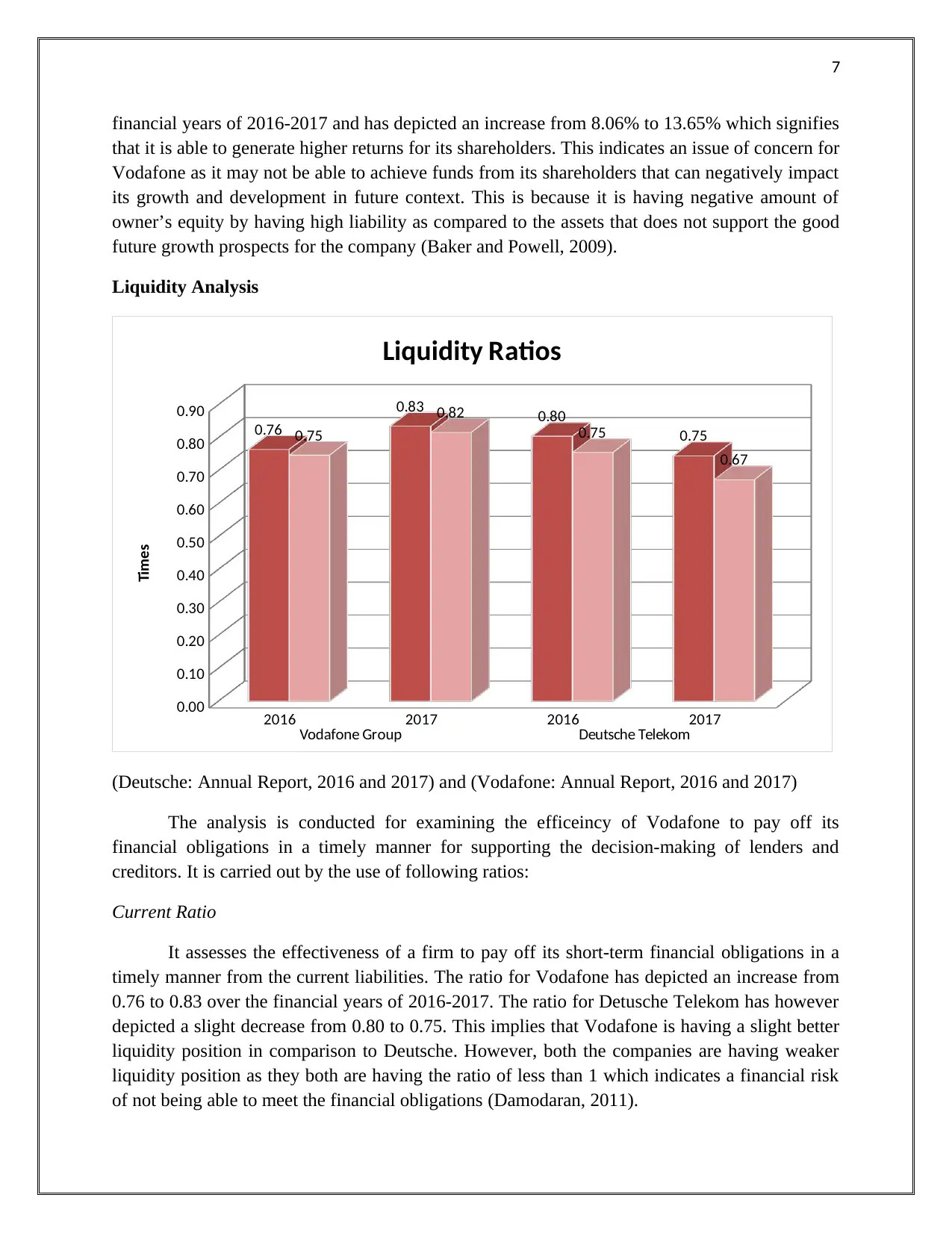
7
financial years of 2016-2017 and has depicted an increase from 8.06% to 13.65% which signifies
that it is able to generate higher returns for its shareholders. This indicates an issue of concern for
Vodafone as it may not be able to achieve funds from its shareholders that can negatively impact
its growth and development in future context. This is because it is having negative amount of
owner’s equity by having high liability as compared to the assets that does not support the good
future growth prospects for the company (Baker and Powell, 2009).
Liquidity Analysis
2016 2017 2016 2017
Vodafone Group Deutsche Telekom
0.00
0.10
0.20
0.30
0.40
0.50
0.60
0.70
0.80
0.90
0.76
0.83 0.80
0.750.75
0.82
0.75
0.67
Liquidity Ratios
Times
(Deutsche: Annual Report, 2016 and 2017) and (Vodafone: Annual Report, 2016 and 2017)
The analysis is conducted for examining the efficeincy of Vodafone to pay off its
financial obligations in a timely manner for supporting the decision-making of lenders and
creditors. It is carried out by the use of following ratios:
Current Ratio
It assesses the effectiveness of a firm to pay off its short-term financial obligations in a
timely manner from the current liabilities. The ratio for Vodafone has depicted an increase from
0.76 to 0.83 over the financial years of 2016-2017. The ratio for Detusche Telekom has however
depicted a slight decrease from 0.80 to 0.75. This implies that Vodafone is having a slight better
liquidity position in comparison to Deutsche. However, both the companies are having weaker
liquidity position as they both are having the ratio of less than 1 which indicates a financial risk
of not being able to meet the financial obligations (Damodaran, 2011).
financial years of 2016-2017 and has depicted an increase from 8.06% to 13.65% which signifies
that it is able to generate higher returns for its shareholders. This indicates an issue of concern for
Vodafone as it may not be able to achieve funds from its shareholders that can negatively impact
its growth and development in future context. This is because it is having negative amount of
owner’s equity by having high liability as compared to the assets that does not support the good
future growth prospects for the company (Baker and Powell, 2009).
Liquidity Analysis
2016 2017 2016 2017
Vodafone Group Deutsche Telekom
0.00
0.10
0.20
0.30
0.40
0.50
0.60
0.70
0.80
0.90
0.76
0.83 0.80
0.750.75
0.82
0.75
0.67
Liquidity Ratios
Times
(Deutsche: Annual Report, 2016 and 2017) and (Vodafone: Annual Report, 2016 and 2017)
The analysis is conducted for examining the efficeincy of Vodafone to pay off its
financial obligations in a timely manner for supporting the decision-making of lenders and
creditors. It is carried out by the use of following ratios:
Current Ratio
It assesses the effectiveness of a firm to pay off its short-term financial obligations in a
timely manner from the current liabilities. The ratio for Vodafone has depicted an increase from
0.76 to 0.83 over the financial years of 2016-2017. The ratio for Detusche Telekom has however
depicted a slight decrease from 0.80 to 0.75. This implies that Vodafone is having a slight better
liquidity position in comparison to Deutsche. However, both the companies are having weaker
liquidity position as they both are having the ratio of less than 1 which indicates a financial risk
of not being able to meet the financial obligations (Damodaran, 2011).
Paraphrase This Document
Need a fresh take? Get an instant paraphrase of this document with our AI Paraphraser
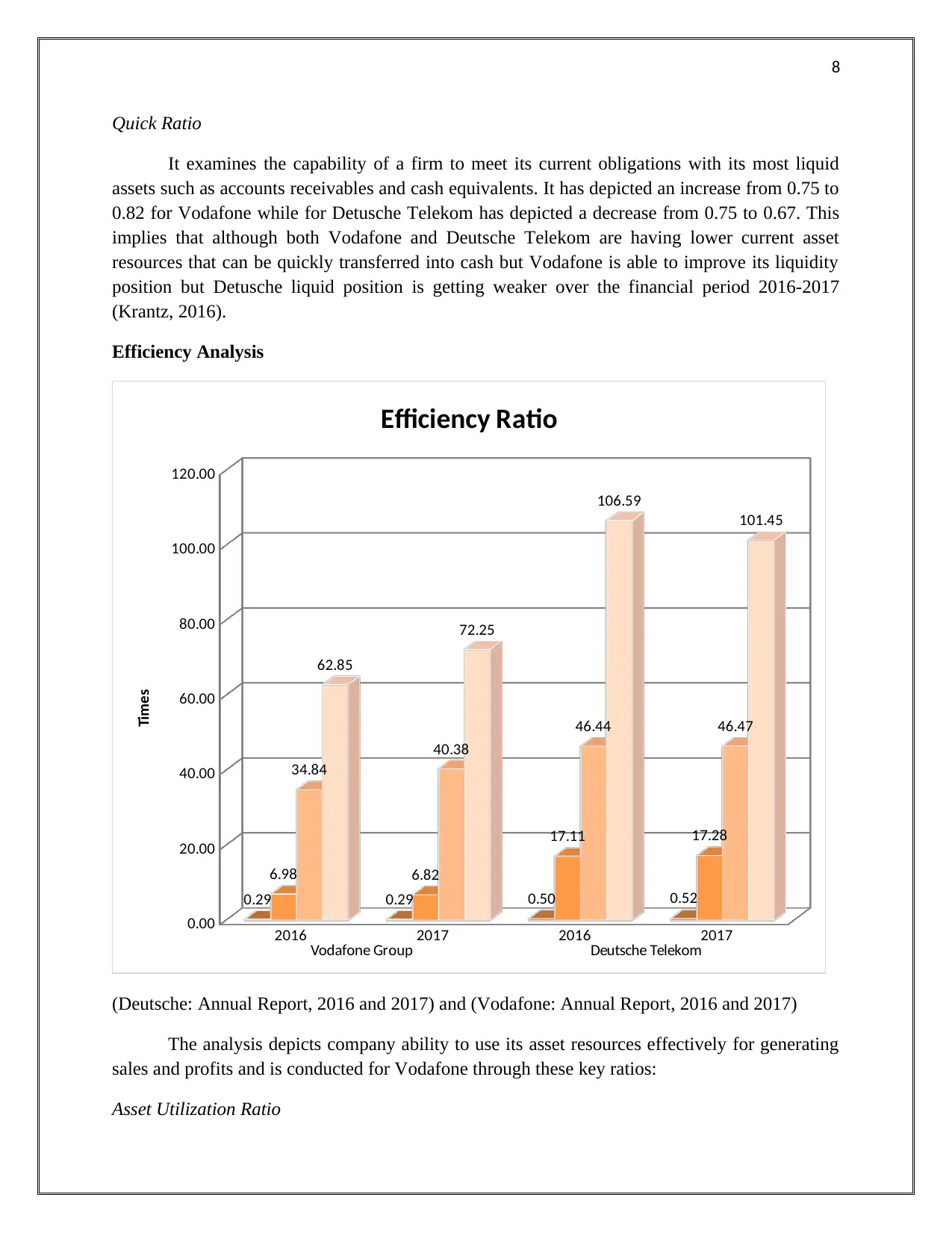
8
Quick Ratio
It examines the capability of a firm to meet its current obligations with its most liquid
assets such as accounts receivables and cash equivalents. It has depicted an increase from 0.75 to
0.82 for Vodafone while for Detusche Telekom has depicted a decrease from 0.75 to 0.67. This
implies that although both Vodafone and Deutsche Telekom are having lower current asset
resources that can be quickly transferred into cash but Vodafone is able to improve its liquidity
position but Detusche liquid position is getting weaker over the financial period 2016-2017
(Krantz, 2016).
Efficiency Analysis
2016 2017 2016 2017
Vodafone Group Deutsche Telekom
0.00
20.00
40.00
60.00
80.00
100.00
120.00
0.29 0.29 0.50 0.52
6.98 6.82
17.11 17.28
34.84
40.38
46.44 46.47
62.85
72.25
106.59
101.45
Efficiency Ratio
Times
(Deutsche: Annual Report, 2016 and 2017) and (Vodafone: Annual Report, 2016 and 2017)
The analysis depicts company ability to use its asset resources effectively for generating
sales and profits and is conducted for Vodafone through these key ratios:
Asset Utilization Ratio
Quick Ratio
It examines the capability of a firm to meet its current obligations with its most liquid
assets such as accounts receivables and cash equivalents. It has depicted an increase from 0.75 to
0.82 for Vodafone while for Detusche Telekom has depicted a decrease from 0.75 to 0.67. This
implies that although both Vodafone and Deutsche Telekom are having lower current asset
resources that can be quickly transferred into cash but Vodafone is able to improve its liquidity
position but Detusche liquid position is getting weaker over the financial period 2016-2017
(Krantz, 2016).
Efficiency Analysis
2016 2017 2016 2017
Vodafone Group Deutsche Telekom
0.00
20.00
40.00
60.00
80.00
100.00
120.00
0.29 0.29 0.50 0.52
6.98 6.82
17.11 17.28
34.84
40.38
46.44 46.47
62.85
72.25
106.59
101.45
Efficiency Ratio
Times
(Deutsche: Annual Report, 2016 and 2017) and (Vodafone: Annual Report, 2016 and 2017)
The analysis depicts company ability to use its asset resources effectively for generating
sales and profits and is conducted for Vodafone through these key ratios:
Asset Utilization Ratio
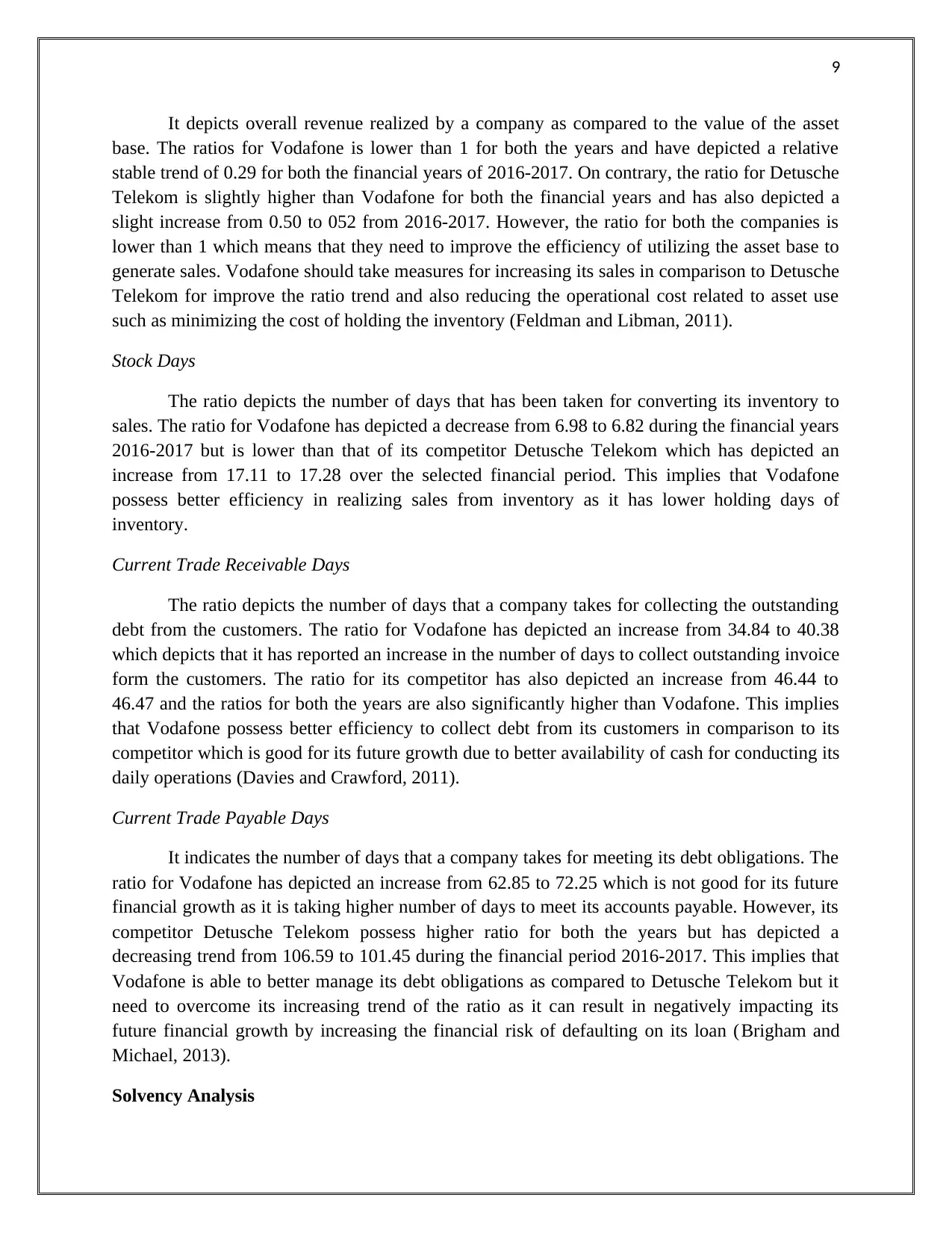
9
It depicts overall revenue realized by a company as compared to the value of the asset
base. The ratios for Vodafone is lower than 1 for both the years and have depicted a relative
stable trend of 0.29 for both the financial years of 2016-2017. On contrary, the ratio for Detusche
Telekom is slightly higher than Vodafone for both the financial years and has also depicted a
slight increase from 0.50 to 052 from 2016-2017. However, the ratio for both the companies is
lower than 1 which means that they need to improve the efficiency of utilizing the asset base to
generate sales. Vodafone should take measures for increasing its sales in comparison to Detusche
Telekom for improve the ratio trend and also reducing the operational cost related to asset use
such as minimizing the cost of holding the inventory (Feldman and Libman, 2011).
Stock Days
The ratio depicts the number of days that has been taken for converting its inventory to
sales. The ratio for Vodafone has depicted a decrease from 6.98 to 6.82 during the financial years
2016-2017 but is lower than that of its competitor Detusche Telekom which has depicted an
increase from 17.11 to 17.28 over the selected financial period. This implies that Vodafone
possess better efficiency in realizing sales from inventory as it has lower holding days of
inventory.
Current Trade Receivable Days
The ratio depicts the number of days that a company takes for collecting the outstanding
debt from the customers. The ratio for Vodafone has depicted an increase from 34.84 to 40.38
which depicts that it has reported an increase in the number of days to collect outstanding invoice
form the customers. The ratio for its competitor has also depicted an increase from 46.44 to
46.47 and the ratios for both the years are also significantly higher than Vodafone. This implies
that Vodafone possess better efficiency to collect debt from its customers in comparison to its
competitor which is good for its future growth due to better availability of cash for conducting its
daily operations (Davies and Crawford, 2011).
Current Trade Payable Days
It indicates the number of days that a company takes for meeting its debt obligations. The
ratio for Vodafone has depicted an increase from 62.85 to 72.25 which is not good for its future
financial growth as it is taking higher number of days to meet its accounts payable. However, its
competitor Detusche Telekom possess higher ratio for both the years but has depicted a
decreasing trend from 106.59 to 101.45 during the financial period 2016-2017. This implies that
Vodafone is able to better manage its debt obligations as compared to Detusche Telekom but it
need to overcome its increasing trend of the ratio as it can result in negatively impacting its
future financial growth by increasing the financial risk of defaulting on its loan (Brigham and
Michael, 2013).
Solvency Analysis
It depicts overall revenue realized by a company as compared to the value of the asset
base. The ratios for Vodafone is lower than 1 for both the years and have depicted a relative
stable trend of 0.29 for both the financial years of 2016-2017. On contrary, the ratio for Detusche
Telekom is slightly higher than Vodafone for both the financial years and has also depicted a
slight increase from 0.50 to 052 from 2016-2017. However, the ratio for both the companies is
lower than 1 which means that they need to improve the efficiency of utilizing the asset base to
generate sales. Vodafone should take measures for increasing its sales in comparison to Detusche
Telekom for improve the ratio trend and also reducing the operational cost related to asset use
such as minimizing the cost of holding the inventory (Feldman and Libman, 2011).
Stock Days
The ratio depicts the number of days that has been taken for converting its inventory to
sales. The ratio for Vodafone has depicted a decrease from 6.98 to 6.82 during the financial years
2016-2017 but is lower than that of its competitor Detusche Telekom which has depicted an
increase from 17.11 to 17.28 over the selected financial period. This implies that Vodafone
possess better efficiency in realizing sales from inventory as it has lower holding days of
inventory.
Current Trade Receivable Days
The ratio depicts the number of days that a company takes for collecting the outstanding
debt from the customers. The ratio for Vodafone has depicted an increase from 34.84 to 40.38
which depicts that it has reported an increase in the number of days to collect outstanding invoice
form the customers. The ratio for its competitor has also depicted an increase from 46.44 to
46.47 and the ratios for both the years are also significantly higher than Vodafone. This implies
that Vodafone possess better efficiency to collect debt from its customers in comparison to its
competitor which is good for its future growth due to better availability of cash for conducting its
daily operations (Davies and Crawford, 2011).
Current Trade Payable Days
It indicates the number of days that a company takes for meeting its debt obligations. The
ratio for Vodafone has depicted an increase from 62.85 to 72.25 which is not good for its future
financial growth as it is taking higher number of days to meet its accounts payable. However, its
competitor Detusche Telekom possess higher ratio for both the years but has depicted a
decreasing trend from 106.59 to 101.45 during the financial period 2016-2017. This implies that
Vodafone is able to better manage its debt obligations as compared to Detusche Telekom but it
need to overcome its increasing trend of the ratio as it can result in negatively impacting its
future financial growth by increasing the financial risk of defaulting on its loan (Brigham and
Michael, 2013).
Solvency Analysis
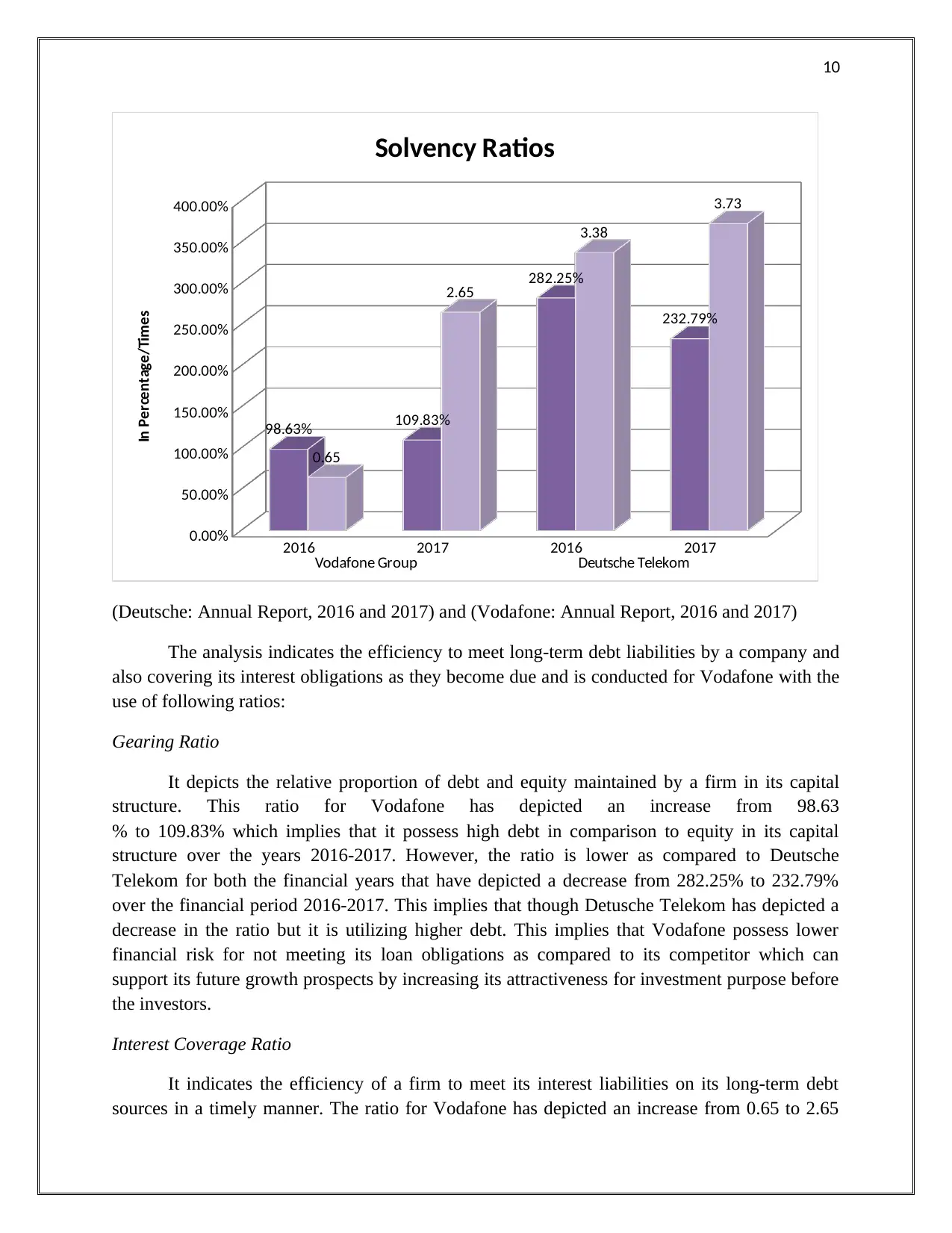
10
2016 2017 2016 2017
Vodafone Group Deutsche Telekom
0.00%
50.00%
100.00%
150.00%
200.00%
250.00%
300.00%
350.00%
400.00%
98.63% 109.83%
282.25%
232.79%
0.65
2.65
3.38
3.73
Solvency Ratios
In Percentage/Times
(Deutsche: Annual Report, 2016 and 2017) and (Vodafone: Annual Report, 2016 and 2017)
The analysis indicates the efficiency to meet long-term debt liabilities by a company and
also covering its interest obligations as they become due and is conducted for Vodafone with the
use of following ratios:
Gearing Ratio
It depicts the relative proportion of debt and equity maintained by a firm in its capital
structure. This ratio for Vodafone has depicted an increase from 98.63
% to 109.83% which implies that it possess high debt in comparison to equity in its capital
structure over the years 2016-2017. However, the ratio is lower as compared to Deutsche
Telekom for both the financial years that have depicted a decrease from 282.25% to 232.79%
over the financial period 2016-2017. This implies that though Detusche Telekom has depicted a
decrease in the ratio but it is utilizing higher debt. This implies that Vodafone possess lower
financial risk for not meeting its loan obligations as compared to its competitor which can
support its future growth prospects by increasing its attractiveness for investment purpose before
the investors.
Interest Coverage Ratio
It indicates the efficiency of a firm to meet its interest liabilities on its long-term debt
sources in a timely manner. The ratio for Vodafone has depicted an increase from 0.65 to 2.65
2016 2017 2016 2017
Vodafone Group Deutsche Telekom
0.00%
50.00%
100.00%
150.00%
200.00%
250.00%
300.00%
350.00%
400.00%
98.63% 109.83%
282.25%
232.79%
0.65
2.65
3.38
3.73
Solvency Ratios
In Percentage/Times
(Deutsche: Annual Report, 2016 and 2017) and (Vodafone: Annual Report, 2016 and 2017)
The analysis indicates the efficiency to meet long-term debt liabilities by a company and
also covering its interest obligations as they become due and is conducted for Vodafone with the
use of following ratios:
Gearing Ratio
It depicts the relative proportion of debt and equity maintained by a firm in its capital
structure. This ratio for Vodafone has depicted an increase from 98.63
% to 109.83% which implies that it possess high debt in comparison to equity in its capital
structure over the years 2016-2017. However, the ratio is lower as compared to Deutsche
Telekom for both the financial years that have depicted a decrease from 282.25% to 232.79%
over the financial period 2016-2017. This implies that though Detusche Telekom has depicted a
decrease in the ratio but it is utilizing higher debt. This implies that Vodafone possess lower
financial risk for not meeting its loan obligations as compared to its competitor which can
support its future growth prospects by increasing its attractiveness for investment purpose before
the investors.
Interest Coverage Ratio
It indicates the efficiency of a firm to meet its interest liabilities on its long-term debt
sources in a timely manner. The ratio for Vodafone has depicted an increase from 0.65 to 2.65
Secure Best Marks with AI Grader
Need help grading? Try our AI Grader for instant feedback on your assignments.
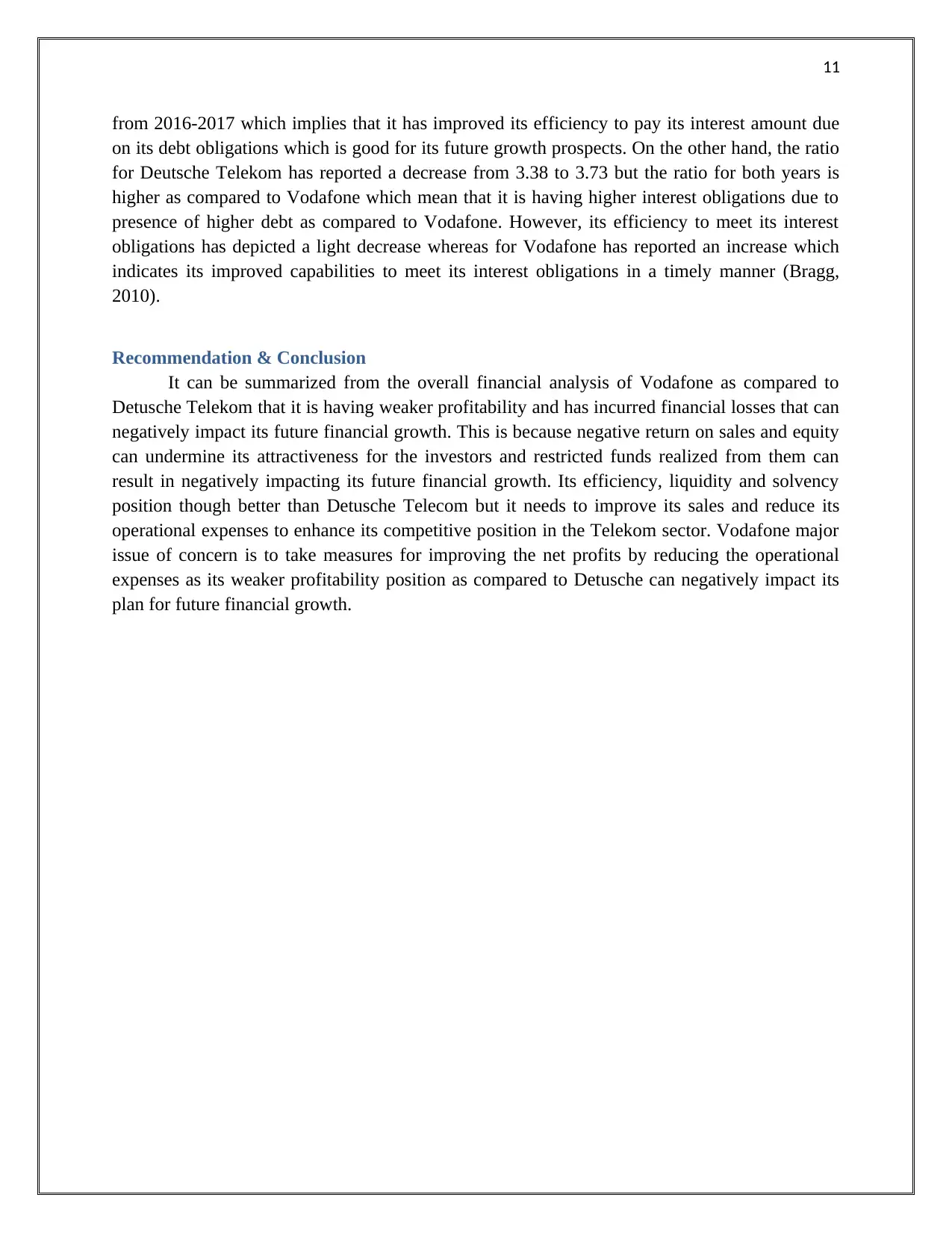
11
from 2016-2017 which implies that it has improved its efficiency to pay its interest amount due
on its debt obligations which is good for its future growth prospects. On the other hand, the ratio
for Deutsche Telekom has reported a decrease from 3.38 to 3.73 but the ratio for both years is
higher as compared to Vodafone which mean that it is having higher interest obligations due to
presence of higher debt as compared to Vodafone. However, its efficiency to meet its interest
obligations has depicted a light decrease whereas for Vodafone has reported an increase which
indicates its improved capabilities to meet its interest obligations in a timely manner (Bragg,
2010).
Recommendation & Conclusion
It can be summarized from the overall financial analysis of Vodafone as compared to
Detusche Telekom that it is having weaker profitability and has incurred financial losses that can
negatively impact its future financial growth. This is because negative return on sales and equity
can undermine its attractiveness for the investors and restricted funds realized from them can
result in negatively impacting its future financial growth. Its efficiency, liquidity and solvency
position though better than Detusche Telecom but it needs to improve its sales and reduce its
operational expenses to enhance its competitive position in the Telekom sector. Vodafone major
issue of concern is to take measures for improving the net profits by reducing the operational
expenses as its weaker profitability position as compared to Detusche can negatively impact its
plan for future financial growth.
from 2016-2017 which implies that it has improved its efficiency to pay its interest amount due
on its debt obligations which is good for its future growth prospects. On the other hand, the ratio
for Deutsche Telekom has reported a decrease from 3.38 to 3.73 but the ratio for both years is
higher as compared to Vodafone which mean that it is having higher interest obligations due to
presence of higher debt as compared to Vodafone. However, its efficiency to meet its interest
obligations has depicted a light decrease whereas for Vodafone has reported an increase which
indicates its improved capabilities to meet its interest obligations in a timely manner (Bragg,
2010).
Recommendation & Conclusion
It can be summarized from the overall financial analysis of Vodafone as compared to
Detusche Telekom that it is having weaker profitability and has incurred financial losses that can
negatively impact its future financial growth. This is because negative return on sales and equity
can undermine its attractiveness for the investors and restricted funds realized from them can
result in negatively impacting its future financial growth. Its efficiency, liquidity and solvency
position though better than Detusche Telecom but it needs to improve its sales and reduce its
operational expenses to enhance its competitive position in the Telekom sector. Vodafone major
issue of concern is to take measures for improving the net profits by reducing the operational
expenses as its weaker profitability position as compared to Detusche can negatively impact its
plan for future financial growth.

12
References
Baker, H. and Powell, G. 2009. Understanding Financial Management: A Practical Guide.
USA: John Wiley & Sons
Bragg, S. 2010. Business Ratios and Formulas: A Comprehensive Guide. US: John Wiley &
Sons.
Brigham, F., and Michael C. 2013. Financial management: Theory & practice. Canada: Cengage
Learning.
Damodaran, A, 2011. Applied corporate finance. USA: John Wiley & sons.
Davies, T. and Crawford, I. 2011. Business accounting and finance. USA: Pearson.
Deutsche: Annual Report. 2016. Deutsche Telecom. [Online]. Available at:
https://www.telekom.com/en/investor-relations [Accessed on: 13 June 2019].
Deutsche: Annual Report. 2017. Deutsche Telecom. [Online]. Available at:
https://www.telekom.com/en/investor-relations [Accessed on: 13 June 2019].
Feldman, M. and Libman, L. 2011. Crash Course in Accounting and Financial Statement
Analysis. USA: John Wiley & Sons.
Joseph, C. 2013. Advanced Credit Risk Analysis and Management. USA: John Wiley & Sons.
Krantz, M. 2016. Fundamental Analysis for Dummies. USA: John Wiley & Sons.
Needles, B. and Powers, M. 2010. Principles of Financial Accounting. Cengage Learning.
Vodafone: Annual Report. 2016. Vodafone Group Limited. [Online]. Available at:
http://www.annualreports.com/Company/vodafone-group-plc [Accessed on: 13 June 2019].
Vodafone: Annual Report. 2017. Vodafone Group Limited. [Online]. Available at:
http://www.annualreports.com/Company/vodafone-group-plc [Accessed on: 13 June 2019].
References
Baker, H. and Powell, G. 2009. Understanding Financial Management: A Practical Guide.
USA: John Wiley & Sons
Bragg, S. 2010. Business Ratios and Formulas: A Comprehensive Guide. US: John Wiley &
Sons.
Brigham, F., and Michael C. 2013. Financial management: Theory & practice. Canada: Cengage
Learning.
Damodaran, A, 2011. Applied corporate finance. USA: John Wiley & sons.
Davies, T. and Crawford, I. 2011. Business accounting and finance. USA: Pearson.
Deutsche: Annual Report. 2016. Deutsche Telecom. [Online]. Available at:
https://www.telekom.com/en/investor-relations [Accessed on: 13 June 2019].
Deutsche: Annual Report. 2017. Deutsche Telecom. [Online]. Available at:
https://www.telekom.com/en/investor-relations [Accessed on: 13 June 2019].
Feldman, M. and Libman, L. 2011. Crash Course in Accounting and Financial Statement
Analysis. USA: John Wiley & Sons.
Joseph, C. 2013. Advanced Credit Risk Analysis and Management. USA: John Wiley & Sons.
Krantz, M. 2016. Fundamental Analysis for Dummies. USA: John Wiley & Sons.
Needles, B. and Powers, M. 2010. Principles of Financial Accounting. Cengage Learning.
Vodafone: Annual Report. 2016. Vodafone Group Limited. [Online]. Available at:
http://www.annualreports.com/Company/vodafone-group-plc [Accessed on: 13 June 2019].
Vodafone: Annual Report. 2017. Vodafone Group Limited. [Online]. Available at:
http://www.annualreports.com/Company/vodafone-group-plc [Accessed on: 13 June 2019].

13
Appendix
Appendix
Paraphrase This Document
Need a fresh take? Get an instant paraphrase of this document with our AI Paraphraser
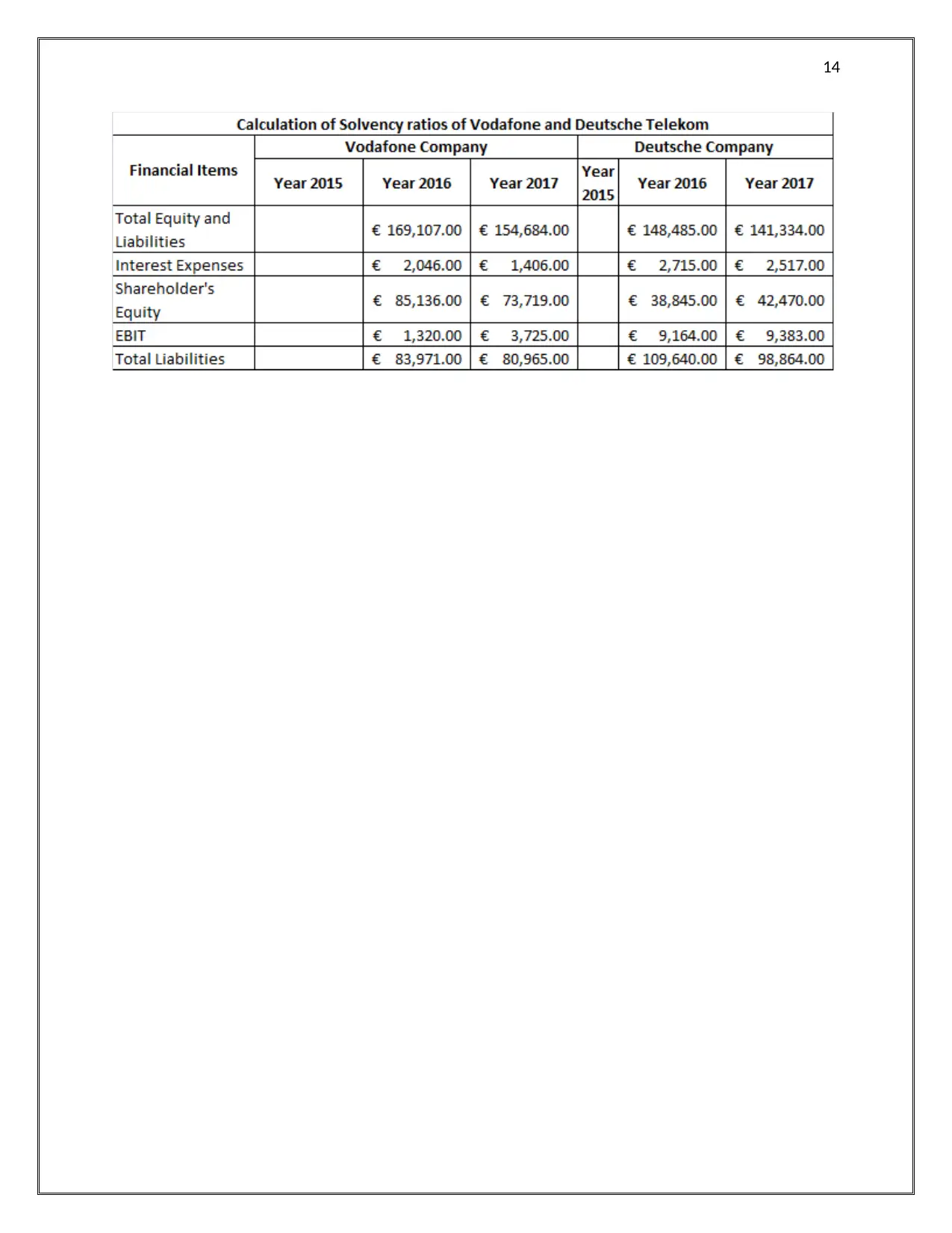
14
1 out of 14
Related Documents
Your All-in-One AI-Powered Toolkit for Academic Success.
+13062052269
info@desklib.com
Available 24*7 on WhatsApp / Email
![[object Object]](/_next/static/media/star-bottom.7253800d.svg)
Unlock your academic potential
© 2024 | Zucol Services PVT LTD | All rights reserved.




